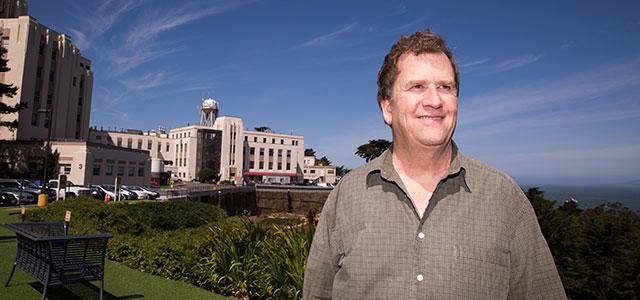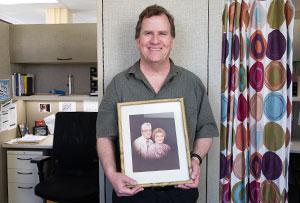
Rafael Romo at the San Francisco Veterans Affairs Medical Center (photos by Elisabeth Fall)
Light Strikes with a Small Hammer: Rafael Romo Seeks Better Ways to Make End-of-Life Decisions
In 2000, Rafael Romo’s mother passed away from multiple myeloma. She had outlived her prognosis by four years, but her son says, “She didn’t have a peaceful death, and I kept thinking there should be a better way.”
Fourteen years later, Romo earned his PhD from UC San Francisco School of Nursing. His dissertation – Decision Making Among Older Adults with a Limited Prognosis – received the 2015 Distinguished Dissertation Award in Nursing. That led to another study and a research letter in JAMA Internal Medicine. Today, Romo is finishing postdoctoral work as a VA Quality Scholars Nurse Fellow at the San Francisco VA Health Care System.
Watching his mother die turned him toward a nursing career.
“In her last six months, the home care nurses told me I had an aptitude for nursing,” he says. “After she died, I began volunteering in hospices and became very passionate about that.”
Until then, Romo had spent his entire working life in the high-tech industry; his 1982 undergraduate degree is in mathematics. Yet a few years after his mother’s death, when his boss asked him to relocate to the division headquarters out of state, Romo said no. His husband is a professor at San Jose State University, and the couple did not want to leave the Bay Area.
“I knew I would eventually lose my job, and I didn’t want to get another one in high-tech,” he says. “It was perfect timing, because I had been thinking about changing careers and doing something with more human impact.”
The plan was to get an associate degree in nursing and become a hospice nurse, but Romo wound up at the University of San Francisco’s master’s-entry option program (MSN for Non-Nurses), a program that is similar to UCSF’s Master’s Entry Program in Nursing. By 2006, he had earned both his RN license and a master’s degree. He went to work in a step-down unit at a local hospital, where the concerns about how patients and their providers talk about prognoses and death were ever present.
“Just like what happened with my mother, my older patients kept asking for care that was giving them outcomes they said they didn’t want,” he says. “I began asking questions and wound up having conversations with professors at UCSF, who told me I needed to get a PhD.”
He was 50 years old and relatively new to nursing, but Romo quickly embraced a research program that seems neatly in sync with changing societal views about hospice and palliative care.
JAMA Study Raises Important Questions
“At the end of life, everyone deserves some kind of palliative care, and I really wanted to look at how these decisions are being made and at the quality of care available,” says Romo.
When his dissertation work revealed a significant disparity between a person’s prognosis and their own predictions of their health, Romo took that finding and ran with it. It led to his JAMA Internal Medicine research letter, which Romo co-authored with his mentor at the VA, UCSF geriatrician Alexander Smith, and a number of other UCSF colleagues. The authors analyzed a group of more than 2,000 adults, ranging in age from 64 to 89, who had been asked what they believed their chances were for living at least another 10 years, and then compared the answers to actual survival and the types of estimates professional guidelines often use when considering diagnostic or treatment interventions.
The key finding: Almost a third of participants underestimated their survival, and more than 10 percent overestimated their survival; overestimation increased significantly with age.
“Now we need to understand how those differences impact patient-clinician communication and the type of treatments and care people receive,” Romo says. “For example, people who underestimate their prognosis might choose to forgo procedures and tests that may be beneficial to them, which is just as harmful as patients who overestimate their prognosis receiving treatments that will cause them to suffer.”
Do We Need Discussions Early and Often?
Romo believes his findings highlight the importance of speaking with people who have a life-threatening illness as early as possible about their prognosis.
“If we start early, we are probably telling people better news than they expect,” he says. “So if someone has diabetes and realizes they can live a long time, they may manage their blood sugar better and avoid complications.”
He adds that having an earlier and more positive discussion establishes a pattern of talking about the prognosis. As an individual’s health declines, the conversation about a changing clinical reality becomes less threatening than it might be if the conversation happened all at once. Such an approach would be very different from what actually happened with both of Romo’s parents.
 Romo with a portrait of his parents “At the very end, the news that my mother was dying was shocking and distressing and difficult for her to believe,” he says. “It can take time for patients to wrap their head around their prognosis.” If they don’t have that time, their distress can muddy their thinking about how much medical intervention they really want, which Romo believes was precisely the case with his mother.
Romo with a portrait of his parents “At the very end, the news that my mother was dying was shocking and distressing and difficult for her to believe,” he says. “It can take time for patients to wrap their head around their prognosis.” If they don’t have that time, their distress can muddy their thinking about how much medical intervention they really want, which Romo believes was precisely the case with his mother.
His father, who died 13 years later from mesothelioma, offers another insight into the value of having both patient and provider comfortable with end-of-life conversations.
“There was only a brief mention at diagnosis that his expected survival was nine months to a year,” says Romo. “When he was offered chemo, it was presented as his only option. His physicians said it would increase his life by three months but didn’t tell him what those three months would be like, and they didn’t offer palliative care; they were very dismissive of it, and they never discussed what made life meaningful to him.”
The result was a man who had been active and independent his entire life spending most of his final days bedridden and dependent on others.
“I was working on my dissertation and driving down all the time to his small desert community outside of Los Angeles. He couldn’t understand the stress of everything that was happening,” says Romo. “In the doctor’s office, we’d talk for 10 minutes, and my father would look at me and ask: ‘What did he say? What did he mean?’”
The nature of the discussions also revealed a cultural divide, which can make discussions even more difficult and less helpful. Though Rafael Romo grew up all over the world as a “military brat,” his father, a natural-born US citizen, had been raised in Mexico due to his family being sent there during mass Depression-era deportations. “My father had very traditional Mexican values, and it was his view that it was his children’s responsibility to take care of him at this stage in his life. He left all the decisions to us,” says Romo.
Drawing on his dissertation research, Romo made decisions that were informed by what he knew his father found meaningful. “In the end, he wound up going into hospice, and they did a fabulous job,” Romo says.
Next Steps
As he completes his VA fellowship and begins a faculty position at the University of Virginia School of Nursing, Romo is developing two projects that he hopes to pursue in his new role. Both dig deeper into whether early and ongoing discussions about prognosis can lead to more satisfactory end-of-life decisions for patients.
For the first, a longitudinal study, Romo wants to work with a racially and ethnically diverse group of older people to examine how changes in perception about their prognosis influence changes in their decisionmaking.
The second would evaluate whether the emerging menu of advanced planning tools designed to improve communication among patients, providers and family members – such as PREPARE, a web site that UCSF geriatrician Rebecca Sudore helped develop – gives individuals a better understanding of their prognosis, allows for better symptom management and enables them to make more satisfactory decisions with less stress.
There are, however, barriers to providers having such discussions with their patients, including the current reimbursement system. “I’m happy Medicare has begun paying for some advanced care planning, but it’s [pretty minimal], so we still tend to wait to have the conversation until it’s very late in a person’s life,” Romo says.
He says patients with heart failure offer a good example of why waiting is problematic. Most people who have the disease will ultimately die from it, but they can live upwards of 20 good years if they are diagnosed early and learn how to manage the disease well. Starting the conversation as soon as possible can facilitate both better management and improved end-of-life decisions.
“But when I was in the step-down unit, I rarely saw that,” he says. “And waiting too long meant that we came in with a sledgehammer: one long conversation when the family was already in distress.”
Worse, he says, many clinicians are unprepared or uncomfortable with the conversation because their mind-set for so long has been geared toward keeping people alive, not helping them die comfortably. In such cases, they not only wield a sledgehammer, but wield it awkwardly.
Romo says training teams of providers how to have these conversations in bits and pieces over time – and reimbursing them for this service – might change the entire process for many families.
“Instead of the sledgehammer, it can be like breaking the news with light strikes of a small hammer,” Romo says. “There is research that says people are very open to that.”



